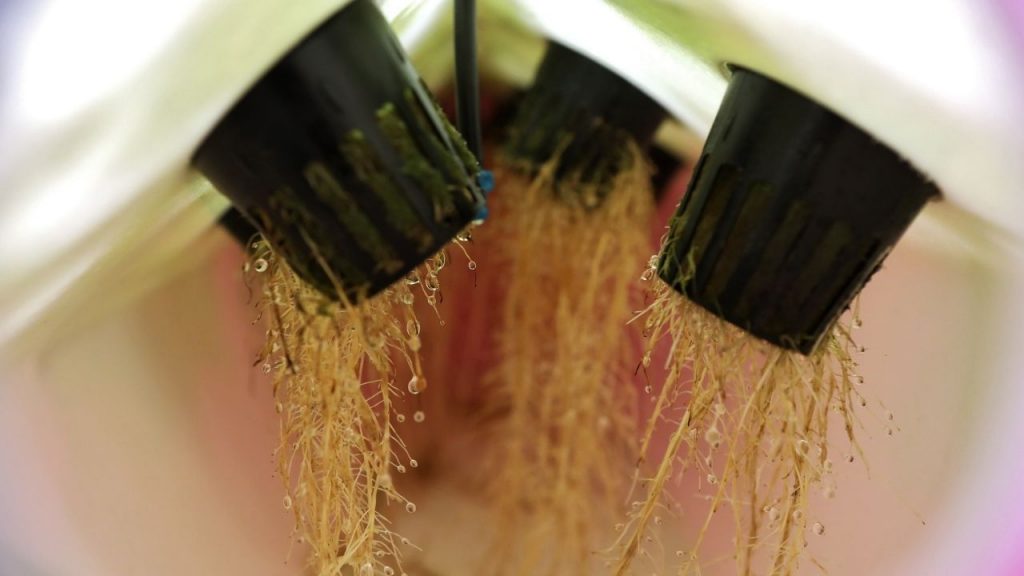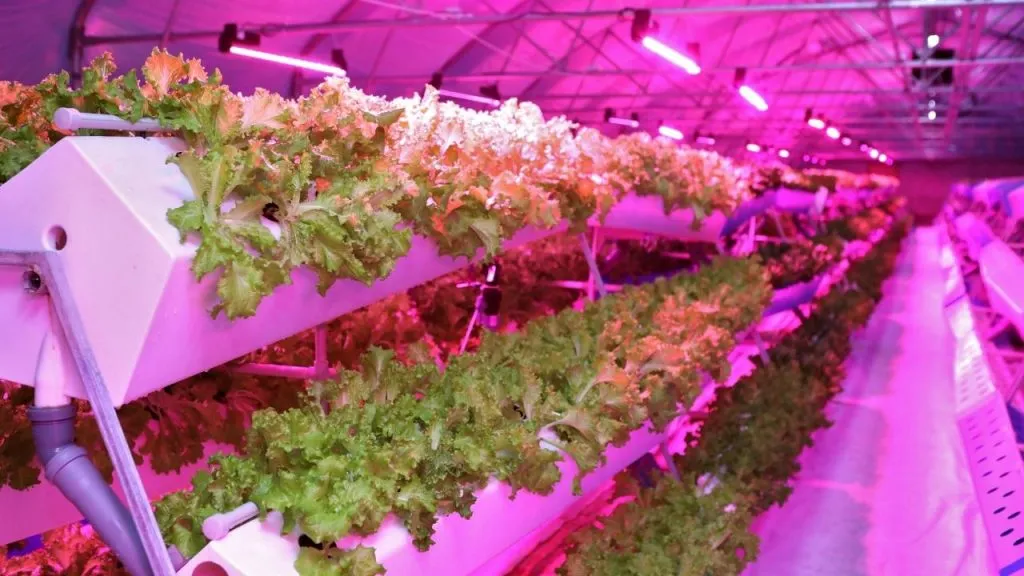Are you planning to invest in the aeroponics growing system, though it looks similar to hydroponics systems? Before making a decision, go through this guide and obtain deep insights into it.
Aeroponics is a great way to garden. You may grow all kinds of Aeroponics plants using this system like tomatoes, potatoes, etc and it’s not as complicated as you might think. In this guide, we’ll walk you through:
- What is an aeroponics growing system
- Types of aeroponics
- Components of aeroponics
- Benefits of aeroponics
- Drawbacks of aeroponics
What Is Aeroponics Growing System?
Aeroponics is a type of gardening system that uses mist or Aeros to provide nutrients to plants.
Unlike other hydroponic systems, aeroponics does not require soil or any other growing medium for the roots of the plants.
Instead, the roots are suspended in air and sprayed with a solution that’s rich in nutrients.
Types of Aeroponics Grow System

1. High-Pressure Aeroponics Systems
High pressure aeroponics (HPA) is a type of aeroponics system that uses a much higher pressure to deliver nutrients to the plant roots.
This results in much more efficient absorption of nutrients, which leads to faster growth rates and larger yields.
However, HPA systems are also much more expensive and require more maintenance than other types of aeroponics systems.
2. Low-Pressure Aeroponics Systems
Low pressure aeroponics (LPA) is a type of aeroponics system that uses a lower pressure to deliver nutrients to the plant roots.
This results in less efficient absorption of nutrients, which leads to slower growth rates and smaller yields.
However, LPA systems are much less expensive and require less maintenance than other types of aeroponic systems.
3. Fogponics Systems
Fogponics is a type of aeroponic system that uses a fine mist to deliver nutrients to the plant roots.
This results in a very efficient absorption of nutrients, which leads to extremely fast growth rates and large yields.
However, fogponics systems are also very expensive and require a lot of maintenance.
4. Drip Aeroponics Systems
Drip aeroponics is a type of aeroponics system that uses a drip line to deliver nutrients to the plant roots.
This results in efficient absorption of nutrients, which leads to fast growth rates and large yields. However, drip aeroponics systems are also expensive and require a lot of maintenance.
Components of an Aeroponics
- Repeat Cycle Timer: A Repeat Cycle Timer controls the pump and misting cycle in an aeroponics system. The timer turns the pump on for a specific time period, then off for a specified duration. This cycle repeats throughout the day.
- Nutrient/ Water Pump: A submersible pump is used to circulate water and nutrients in an aeroponics system.
- Mister Nozzles: Mister nozzles are used to create a fine mist of water and nutrients that is sprayed on the roots of plants in an aeroponics system.
- Reservoir: The reservoir holds water and nutrients that the pump circulates around the system.
- Growing Chamber: The growing chamber is where plants are grown in an aeroponics system.
It is typically made out of a material that is transparent or translucent so that light can penetrate it and reach the plants inside.
Benefits of Aeroponics
Some benefits of aeroponics include:

1. Plants Grow Up to Three Times Faster
Aeroponics is a type of hydroponics system that doesn’t use any growing medium. Instead, the roots are suspended in air and constantly sprayed with a nutrient-rich solution.
Because the roots are not bound by a growing medium, they have access to more oxygen. This allows them to grow up to three times faster than the plants that grow in soil.
2. Yields Increase by 30% on Average
Not only do plants grow faster in an aeroponics system, but they also yield more.
Studies suggest that plants that are grown in aeroponics systems produce 30% more fruit or vegetables than plants that are grown in soil.
This is likely due to the fact that the roots have constant access to nutrients and oxygen. When roots are stressed, they produce fewer fruits and vegetables.
So, by keeping the roots healthy and happy, you can increase your yields.
3. Pests and Diseases Are Less of a Problem
Plants grown in aeroponics systems are less likely to be troubled by pests and diseases. This is because the roots are not in contact with any other plants or growing mediums.
Pests and diseases often spread through contact with other plants or contaminated growing mediums. But, in an aeroponics system, the roots are isolated from other plants and growing mediums.
This makes it difficult for pests and diseases to spread from plant to plant. As a result, plants grown in aeroponics systems are less likely to be troubled by pests and diseases.
4. Vertical Design Means Less Space Needed
Aeroponics systems are often designed vertically. This indicates that they utilize less space than other types of hydroponics systems.
If you’re short on space, or if you want to maximize the number of plants you can grow in a small area, then an aeroponics system is a great option.
5. Lesser Water Consumption
Aeroponics systems use less water than other types of hydroponics systems. This is because the roots are constantly sprayed with a nutrient-rich solution.
The solution is then recirculated and reused. As a result, aeroponics systems use up to 98% less water than soil-based gardening.
This makes aeroponics a perfect solution for those who wish to conserve water.
6. Ideal for Growing Nutrient-Rich Plants
Aeroponics systems are ideal for growing nutrient-rich plants. This is because the roots have constant access to nutrients.
When the roots are stressed, they produce fewer fruits and vegetables. So, by keeping the roots healthy and happy, you can increase your yields.
Aeroponics systems are also great for growing plants that require a lot of nutrients. This is because the roots have constant access to nutrients.
Drawbacks of Aeroponics
Here are some disadvantages of using an aeroponics growing system:
1. Power Outages Can Halt the System
If the power goes out, the aeroponics system will shut down. This can be a problem if you are relying on the system to provide food for your family or business.
If you live in a region where power outages are common, you may want to consider another type of growing system.
2. High Set Up Costs
Set-up costs for aeroponics systems can be hefty. If you are looking for a low-cost option for growing your own food, aeroponics may not be the best choice.
You will need to factor in the cost of the equipment, as well as the cost of running and maintaining the system when deciding if aeroponics is right for you.
3. Can Be Noisy
The pumps used for circulating the nutrient solution can be noisy. If you are looking for a quiet growing system, aeroponics may not be the best choice.
4. Demands Technical Knowledge
Aeroponics systems can be complicated to set up and maintain. They require a certain level of technical know-how to launch, operate, and maintain.
If you aren’t comfortable working with complex machinery, consider another type of growing system.
You will need to have a basic understanding of plumbing and electrical work in order to set up and maintain an aeroponics system.
5. Regular Disinfection of the Root Chamber Is Mandatory
The root chamber of an aeroponics system must be regularly disinfected to prevent the growth of mold and bacteria. This can be a tedious and time-consuming task.
6. Technical Glitches Are an Ongoing Problem
With any complex system, there are bound to be technical glitches. Aeroponics systems are no exception. If the system faces some failure or issue, troubleshooting and fixing the problem can be a headache.
This can be frustrating, especially if you are relying on the system to provide food for your family or business.
Aeroponics FAQs
Some commonly asked questions about Aeroponics Growing Systems include:
Q: Can You Grow Anything With Aeroponics?
Yes, you can grow anything you want with aeroponics!
This type of gardening is becoming increasingly popular because it is so versatile and easy to use.
Whether you want to grow herbs, fruits, or vegetables, aeroponics can help you achieve your gardening goals.
Q: Is Aeroponics Better Than Hydroponics?
There’s no easy answer to this question since it depends on a number of factors.
In general, though, aeroponics can be seen as an improvement over hydroponics since it offers a number of advantages.
For example, aeroponics uses less water than hydroponics since the roots are constantly misted with water rather than being submerged in it.
Q: What Do I Need For An Aeroponics Growing System?
For an aeroponics growing system, you will need a chamber to house your plants, a water pump, an air pump, and a nutrient solution.
The chamber can be made out of a variety of materials, but it should be light-proof and water-tight.
The water pump will circulate the nutrient solution through the chamber, and the air pump will provide aeration to the roots.
The nutrient solution should be specially formulated for aeroponics and should be changed regularly.
Q: How Frequently Should The Aeroponics System Be Watered?
The main difference between aeroponics and other watering methods is that aeroponics doesn’t rely on soil to help support the plant.
This means that the roots are constantly exposed to air and water, which can dry them out quickly.
As a result, you must water your aeroponics system more often than you would a traditional garden. You should mist for three minutes every five minutes.

My name is Olivia, and I live in the United States and love having plants in my garden. Lots of plants are there on my balcony, indoor and outdoor garden also. Here I am trying to share useful gardening tips, how to grow and care for various plants, etc.
